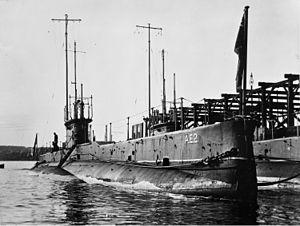HMAS AE2 Batığı
- Tür: Batık, Kalıntı
- Tema: Çanakkale Savaşı
- Kültür: İngiliz, Osmanlı
- Yüzyıl: 20. yy
- Bölge: Türkiye, Marmara Bölgesi, Çanakkale, Biga, Karabiga
 HMAS AE2, in dock in Sydney, c. 1914
| |
| History | |
|---|---|
| Builder | Vickers Armstrong |
| Laid down | 10 February 1912 |
| Launched | 18 June 1913 |
| Commissioned | 28 February 1914 |
| Honours and awards |
|
| Fate | Scuttled, 30 April 1915 |
| General characteristics | |
| Class and type | E-class submarine |
| Displacement | 750 long tons (762 t) surfaced |
| Length | 181 ft (55 m) |
| Beam | 22 ft 6 in (6.86 m) |
| Draught | 12 ft 6 in (3.81 m) |
| Installed power |
|
| Propulsion | 2 × propeller shafts |
| Speed |
|
| Range |
|
| Test depth | 200 feet (61.0 m) |
| Complement | 34 |
| Armament | 4 × 18-inch torpedo tubes |
HMAS AE2 (originally known as AE2) was an E-class submarine of the Royal Australian Navy (RAN). One of two submarines ordered for the fledgling navy, AE2 was built by Vickers Armstrong in England and was commissioned into the RAN in 1914. Together with her sister submarine, HMAS AE1, the boat then sailed to Australia in what was, at the time, the longest voyage ever undertaken by a submarine.
After the start of World War I, AE2 was sent to German New Guinea with the Australian Naval and Military Expeditionary Force, then spent time patrolling around Fiji. With no need for submarines in the Pacific or Indian theatres, AE2 was towed to the Mediterranean, and arrived off Egypt in early 1915. The boat was assigned to the Dardanelles Campaign, and was the first submarine to successfully penetrate the waterway and enter the Sea of Marmara. With orders to "run amok" inside Turkish territory, AE2 operated for five days before mechanical faults forced her to the surface, where she was damaged by the torpedo boat Sultanhisar. The submarine was scuttled by her crew, all of whom were captured.
AE2 was the only RAN vessel lost to enemy action during World War I. The Rahmi M. Koç Museum began searching for the wreck in 1995, and found it in 1998. After another expedition in 2008, the Australian and Turkish Governments decided to leave the boat in place.